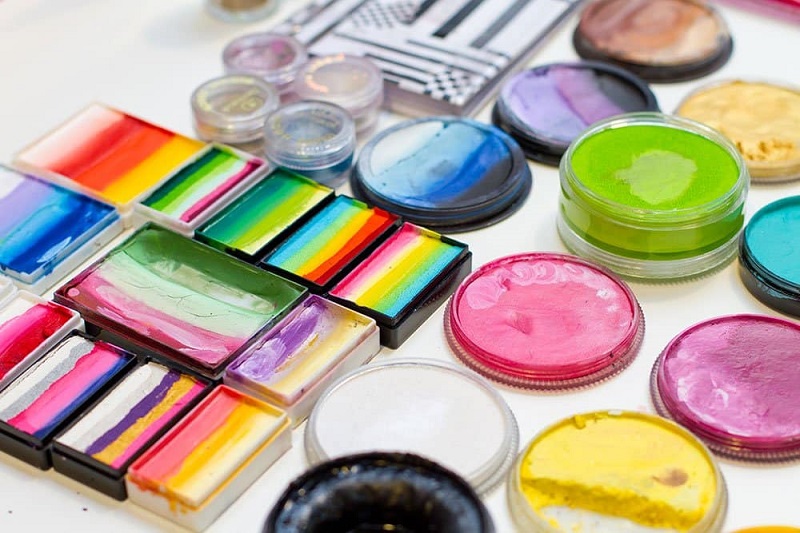Who doesn't love a bit of colour in their life? Face and body painting have been around for centuries, serving various purposes from religious ceremonies to theatrical performances. Today, it's a popular form of artistic expression and entertainment for both children and adults. Whether you're gearing up for a festival, planning a children's party, or just looking to unleash your inner artist, this guide will walk you through everything you need to know about face and body paints.
The Basics: What Are Face and Body Paints?
At their core, face and body paints are specially formulated pigments designed to be applied safely to human skin. Unlike regular paints, high-quality face paints for sale are created with ingredients that are non-toxic and less likely to cause allergic reactions. They come in various forms - creams, liquids, powders, and even pencils or crayons. Each type has unique properties and is suited for different styles of painting.
Safety First: Choosing the Right Products
When it comes to painting on skin, safety should always be your top priority. After all, you don't want your fun day of painting to end up with itchy rashes or worse! Here are some key points to keep in mind:
- Look for hypoallergenic products: These are less likely to cause allergic reactions, especially important for those with sensitive skin.
- Check the ingredients: Avoid paints containing lead, mercury, or other harmful chemicals. Stick to products specifically labelled as face or body paints.
- Patch test: Before going all out, do a small patch test on the inside of your elbow and wait 24 hours to check for any adverse reactions.
- Expiration dates: Yes, face and body paints do expire! Using old products can lead to skin irritation or infections.
Remember, what's safe for your face might not be safe for the area around your eyes. Always check the product labels on face paints for sale and follow the specific usage instructions.
Joy and Art: What is Face Painting?
Face painting is more than just applying colours to the skin – it's an experience that brings joy and excitement to both the painter and the painted. It allows people to transform into anyone or anything they can imagine. Whether it's a child becoming their favourite superhero or an adult embodying a mythical creature, the process of transformation is thrilling and liberating. A well-executed face painting can boost confidence, especially for children. It allows them to step into a different persona and often encourages them to be more outgoing and expressive.
For artists, face painting offers a unique canvas that brings their creations to life. The interplay between the paint and the contours of the face or body presents exciting creative challenges and opportunities. Face painting events, whether at parties, festivals, or community gatherings, foster social connections. The shared experience of getting painted and admiring each other's designs creates a sense of shared joy.
Getting Started: Essential Tools and Techniques
Now that we've covered safety, let's dive into the fun part - actually painting! Here's what you'll need to get started:
- A set of good- quality body and face paints
- Various sizes of brushes (synthetic brushes work well and are easy to clean)
- Sponges for applying base colours and creating textures
- Clean water for rinsing brushes and diluting paints
- Paper towels or a clean cloth for blotting and cleaning up
When it comes to techniques, start simple and work your way up. Begin with basic shapes and lines, then progress to more complex designs as you gain confidence. Here are some beginner-friendly techniques to try:
- Sponging: Great for covering large areas quickly or creating textured backgrounds.
- Brushwork: Use different brush sizes for outlines, details, and filling in areas.
- Stippling: Create interesting textures by gently tapping the brush onto the skin.
- Blending: Mix colours directly on the skin for smooth gradients and shading.
Don't be afraid to experiment and make mistakes - that's how you learn and develop your own style!
Design Ideas: From Simple to Spectacular
The world of face and body painting is incredibly diverse. You can create anything from a simple butterfly on a child's cheek to elaborate full-body art. Animals are always a hit with kids - think tigers, cats, dogs, or even exotic creatures like peacocks. They also love their superheroes, comic book characters, and fantasy creatures, fairies, dragons, or aliens. Adults may prefer more abstract designs or cultural motifs. Let your creativity flow with swirls, geometric shapes, and patterns, or draw inspiration from traditional designs around the world.
Remember, practice makes perfect. Start with simpler designs and gradually challenge yourself with more complex ones as your skills improve.
Caring for Your Skin: Before and After Painting
To ensure a comfortable and safe face painting experience, proper skin care is essential.
Before painting, cleanse your face thoroughly to remove any oils or makeup. If you have very dry skin, apply a light, non-greasy moisturizer and let it absorb completely before painting. For those with sensitive skin, consider using a barrier cream before applying paint.
After painting, remove the paint gently using soap and warm water. For stubborn areas, you might need to use a mild makeup remover. Moisturize your skin after cleaning to prevent dryness. If you notice any irritation, redness, or itching, wash the paint off immediately and discontinue use.
In Conclusion: Express Yourself Through Colour
Face and body painting is an art form that allows for incredible creativity and self-expression. Whether you're painting a child's face at a birthday party or creating an elaborate design for a performance, the joy of transformation is undeniable. Remember to always prioritize safety, start with the basics, and let your imagination take over. With practice and patience, you'll soon be creating stunning designs that bring smiles to faces (quite literally!). So grab your brushes, pick up those paints, and let's add some colour to the world!